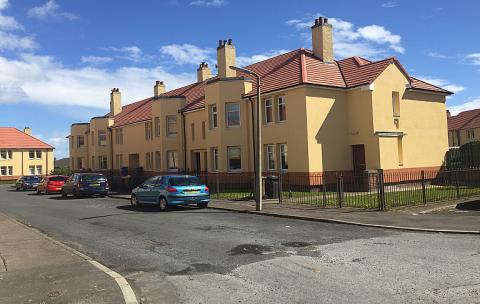Tackling fuel poverty and improving the energy efficiency of the hard to treat buildings through Home Energy Efficiency Programme Scotland – Area Based Schemes (HEEPS-ABS) programme in Dundee.

Dundee City Council
Go To WebsiteAddressed Challenges:
- Air pollution
- Carbon emissions
- Health & wellbeing
Action Areas:
- Energy
- Built Environment
Initiative Purpose:
- Mitigation & Adaptation
The Story

Dundee City Council's EWI projects are funded by Home Energy Efficiency Programme Scotland – Area Based Schemes (HEEPS-ABS) and by combining it with the council's own capital budget and ECO funding from SSE to externally insulate mixed tenure blocks of flats in former Council estates that are either solid wall or non-traditional construction.
In 2019/20 EWI was installed in 3 large areas of Dundee in Stirling Park, Law Crescent and Dudhope. 567 properties - occupied by both Council and private residents - benefited from the upgrades. The total cost of this work was £5.2m with £2.8 coming from the Scottish Government in the form of HEEPS:ABS funding for the private owners.
This brings the total investment in EWI in the city since the inception of the EWI Programme in 2013 up to just under £47m with almost 5,000 residents in Dundee seeing their properties thermally upgraded.
For 2020/21 the Council was allocated over £2m of HEEPS:ABS but due to the effects of COVID-19 and the introduction of the new PAS:2035 retrofit standard, the number of properties that could be insulated was greatly reduced. Work was able to proceed in the Alpin and Foggyley areas but works due in Fleming Gardens, Glenprosen, Lawton 1st and Linlathen areas has been carried forward to 2021/22.
Success & Outcomes
Dundee city council's EWI projects are delivered under The Home Energy Efficiency Programmes for Scotland: Area Based Scheme (HEEPS: ABS). The HEEPS:ABS schemes are designed and delivered by Local Authorities, in conjunction with utility companies and local delivery partners, targeting fuel poor areas to provide energy efficiency measures to a large number of Scottish households to help reduce fuel poverty. It is primarily an insulation programme delivering solid wall and hard-to-treat cavity wall insulation.
This is a successful programme as it allows the council's Housing team to 'unlock' larger mixed tenure schemes where a mix of social and private sector properties in whole street and/or neighbourhood benefit from EWI and other energy efficiency retrofit. This programme is usually delivered in conjunction with ECO funding and council's own capital budget which enables a whole-house retrofit approach, not just external wall insulation. This helps upgrade the buildings to a much better standard, reduce fuel bill of the households, reduce carbon emissions, improve the housing stock of whole neighbourhood and have wider positive impact in the community.
Advice for others looking to do something similar
The drawback is that the funding is on yearly round which which keeps the Housing team in constant pressure to identify the project, carry out stakeholder engagement, prepare project plan, and apply for funding every year. The short-term nature may also hinder the innovation in project. So if any other local authority or social housing organisation is planning HEEBS:ABS or similar project, it may be useful to identify the long list of potential areas with retrofit opportunity and rank them according to the retrofit opportunity. Then start developing project plan on annual basis based on the priority. This will enable team to save time in project identification.
